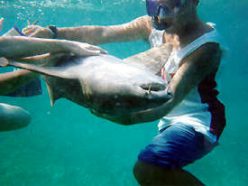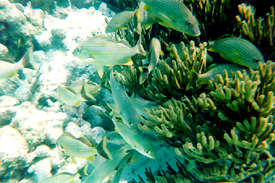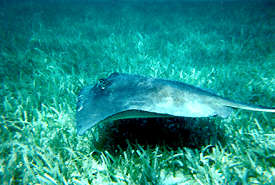Swimming with sharks and stingrays
Marine reserves not only protect sharks, fish, and other sea creatures but also allow people to interact with them.
By Emily Sohn
Hol Chan Marine Reserve, Belize.
Before we even got off the boat, we saw their shadowy figures in the clear water below.
As Norman Eiley, our boat driver, prepared to cast anchor, a handful of sharks and stingrays swam beneath the boat’s wake. The 15 high school students I was traveling with started to squeal. “I never get to see sharks in the water!” said Emma Cooper-Mullin, 17, from Irvington, N.Y., with fins and snorkel in hand. “I really want to swim with one.”
 |
|
Holding a nurse shark at the Hol Chan Marine Reserve in Belize.
|
| AmbergrisCaye.com |
Within minutes, we were all in the water, making that dream come true. For the next hour, we snorkeled with a handful of nurse sharks and southern stingrays at Shark Ray Alley—a shallow sandbar just south of Ambergris Caye, an island in northern Belize. Shark Ray Alley is part of the Hol Chan Marine Reserve. It is illegal to catch fish there. Instead, tourism is the main draw.
Every day, boats full of tourists arrive at Shark Ray Alley, where tour guides feed chunks of fish guts to the animals. As a result, the area’s sharks and rays—some bigger than we are—have become so used to people that they’ll swim right up to you and even let you touch them.
And that’s the problem. Just days before we snorkeled at Shark Ray Alley, Norman told me, a fisherman from the mainland had cruised in at 4 in the morning, caught 9 or 10 nurse sharks, and killed them to sell their fins and meat.
“People noticed them missing that day,” Norman said. “They were complaining—no sharks, no sharks, no sharks. Nobody has ever done something like this before on a large scale.”
Underwater national parks
Marine reserves, or sanctuaries, are supposed to prevent such incidents from happening. Like national parks under water, marine reserves are set up to protect designated areas of the ocean from fishing, instead favoring research, education, and tourism.
Published research on the benefits of marine reserves worldwide has exploded in recent years, says Jim Bohnsack, a fisheries biologist at the National Marine Fisheries Service in Miami. “The scientific community is 99 percent supportive of marine reserves,” he says. “They work for protecting biodiversity and protecting resources.”
The idea is that a carefully designed network of protected areas should help the health of the entire ocean. Fish and other creatures can grow up safely inside reserves before spilling over the edges, where they become fair game for fishermen.
 |
|
The Hol Chan Marine Reserve protects fish and other sea creatures.
|
| AmbergrisCaye.com |
“It’s like an insurance policy,” Bohnsack says. “If you make mistakes, you have something in the bank, like a savings account, that can help resupply areas that have been overfished.”
In support of marine reserves, Bohnsack points to evidence that bigger fish tend to lay more eggs. So, fish inside reserves should be more likely to produce even more fish with stronger genes. In theory, everyone wins, including fishermen and conservationists.
“It’s like having your cake and eating it, too,” Bohnsack says.
Boosting conservation
Marine reserves also make sense economically, says Charles Acosta, an ecologist at Northern Kentucky University. By tracking lobsters, queen conch, and other animals with radio technology and using mathematical models to analyze population patterns, Acosta and his colleagues have come up with dollar figures to show fishermen that conservation will actually boost their business in the long run.
Acosta’s work has contributed to a debate over what marine reserves should look like. “One of our biggest, most important results has been that there is a limit that you cannot go below in terms of size of reserve,” he says. “If the reserve is too small, it will have no effect at all.”
 |
|
A southern stingray.
|
| AmbergrisCaye.com |
Still, plans to create marine reserves are often controversial, especially in places like the Florida Keys, where the fishing industry has a lot of money at stake.
And even after reserves are established, enforcement is often difficult and more expensive than most developing countries can afford. At Hol Chan, a ranger zooms around all day long, collecting fees from snorkelers and divers who visit the area.
You can pay a fine of up to $500 if you get caught stealing even a piece of coral. Other reserves rely more on word-of-mouth and the honor principle for protection.
Sharks in the wild
Unfortunately, those kinds of systems can backfire, as the recent incident at Shark Ray Alley demonstrates. “To have all those sharks living in one place is setting them up for something like this to happen,” said Norman, who is also treasurer of the Belizean Tour Guide Association. He is now determined to track down and punish the shark poachers and to revise enforcement policies in Belize. “We all depended on the honesty of fishermen,” he said.
Besides, Norman added, maybe it’s better not to turn shark sightings into humdrum, everyday events. “It used to be when you saw a nurse shark it was like, ‘Wow!,'” he said. “But after going to Shark Ray Alley, it’s like ‘Oh, there’s another one.’ The element of surprise has changed.”
Given a choice between seeing a shark by chance in the wild and seeing a shark at a place like Sting Ray Alley, most of the students in our group reluctantly agreed. “I guess I would rather see sharks when no one else was around than at Shark Ray Alley,” Emma said on the boat ride back to Ambergris Caye.
Her classmate Cheryl Berman, an 18-year-old senior from Armonk, N.Y., wasn’t so sure. “I think both are pretty cool.”
Going Deeper:







